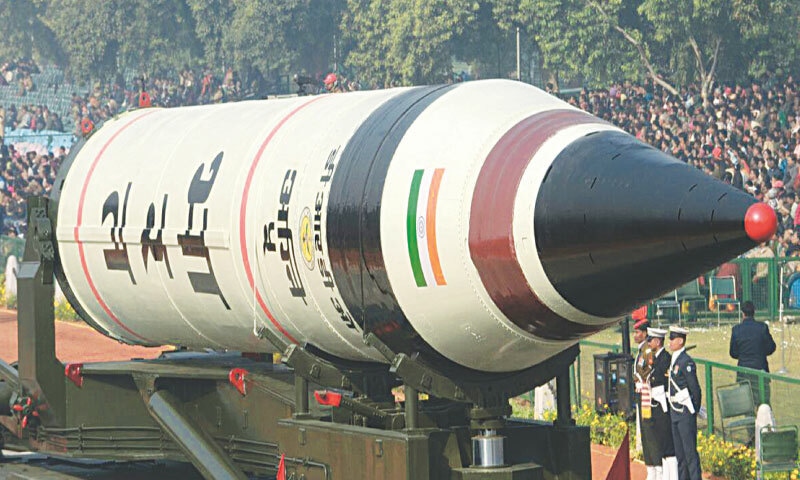India is reportedly modifying its Agni- V intercontinental ballistic missile (ICBM) to carry a colossal 7,500 kg conventional warhead instead of a nuclear payload in pursuit of developing a missile-based delivery system for bunker busters. With the penetration vision of underground 80-100 metres, this massive eight- tonne warhead can destroy deeply buried targets. These bunker busters will enable India to strike adversary’s critical infrastructure with enhanced operational flexibility and survivability of the launch platform. This significant strategic development in India’s missile program ushers a precarious new chapter in South Asia’s strategic landscape, blurring lines between conventional and nuclear strategy.
Recently, the United States used Massive Ordinance Penetrator (MOP) bunker-buster bombs in Fordow and Natanz against Iran’s underground nuclear facilities. Imitating US conventional munitions, that have ability to destroy nuclear infrastructure, India’s Defense Research and Development Organisation (DRDO) reportedly aims to develop airburst warhead for surface targets and like the US GBU-57 a true earth- penetrator (MOP) bomb, allowing India to strike at a long range targets with greater precision.
As per reports, new Agni-V variant would have the capacity to target enemy’s critical infrastructure, missile silos and command centers which are buried deep underground. The development of a missile that can carry bunker buster would allow India to threaten nuclear assets of its rival states with a conventional warhead; however, such an action would most likely cross the nuclear threshold, thereby heightening the risks of escalation.
In tandem with its official nuclear doctrine of ‘No First Use’ (NFU) of nuclear weapons, attacking nuclear assets of adversary with its conventional Agni –V would technically allow India enough room to blur lines between its conventional and nuclear strategy. This nuclear-conventional entanglement would undermine strategic stability in South Asia as development of new bunker buster would offer counterforce options to India, therefore, would be a grave security risk for Pakistan and China.
Regardless of the warhead type, Pakistan would see firing of high-speed ballistic missile as a part of a nuclear first strike. In time of crisis chances of miscalculation would arise multifold as Pakistan would be in difficult position to gauge nature of warhead type within few minutes as potential warhead would have already detonated on desired target, providing little time to distinguish between a conventional high explosive warhead or a nuclear bomb.
With the development of such counterforce capabilities, Indian threats of pre-emptive strikes against nuclear assets of adversary will be maximized, particularly in light of Prime Minister Modi’s remarks in 2019 that hinted at a possible review of India’s NFU doctrine. The new Agni-V variant will allow attacks on storage sites or command-and-control bunkers, presenting strategic assets not as off-limits unless an all-out war has initiated; however, such a development disregards the existing Confidence-Building Measures such as the bilateral agreement of Non-Attack Agreement of 1988 on nuclear facilities, which already ensure the safety of civilian nuclear facilities and indicate that India had no rationale to pursue this capability. This agreement was aimed at reducing nuclear-conventional entanglement between Pakistan and India in times of crisis.
Such ambiguity would create pressure on Pakistan to either pre-empt or respond in a similar manner to secure its deterrent. The use-it-or-lose-it dilemma incentivizes Pakistan for a pre-emption strike especially when India is moving towards counterforce targeting. Conventional attack on adversary nuclear assets would target states in a use it or lose it dilemma. Fear of such a disarming strike against target state can lead to inadvertent escalation between the two nuclear weapon states.
India’s emerging counterforce capabilities necessitate Pakistan to develop extensive early warning networks to ensure stable deterrence. Chances of inadvertent escalation between Pakistan and India that could potentially lead to nuclear war could be minimized through regular communication channels. Furthermore, New Emerging and Disruptive technologies (EDTs) have also blurred line between conventional and nuclear strategies, making nuclear assets vulnerable, inviting miscalculations between nuclear armed states. For example, with little warning, nuclear command-and-control system becomes vulnerable to precision guided hypersonic weapons and at the same time advanced cyber capabilities have the capacity to disable or manipulate early warning networks. Therefore, Development of such conventional mega-missiles displays India’s counterforce temptation, accelerating nuclear arms race in South Asia.
While India pursues development of bunker buster with counterforce preemption and decapitation capabilities, Pakistan continues to adhere with its Full Spectrum Deterrence (FSD) Posture, aiming to ensure deterrence across its entire spectrum with a proportionate, measured and timely response.

Table of Contents
ToggleNawal Nawaz
Nawal Nawaz is a research assistant at Center for International Strategic Studies, Islamabad and an M Phil Scholar in Strategic Studies from National Defence University, Islamabad













